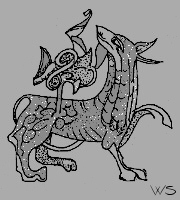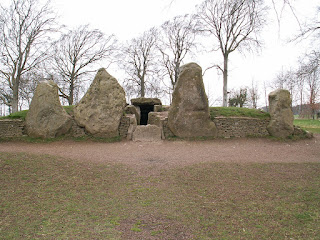In earlier blog-posts, I explored the survival of the Anglo-Saxon poem, Beowulf, and the likely contexts for the poem's performance in the mead-halls of Anglo-Saxon royal courts. Kim Rendfeld has also discussed the origins of the two monsters that the eponymous hero has to defeat in the early stages of the poem, Grendel and his terrifying mother. These early conflicts represent a rite of passage that rulers in the real world of the early Middle Ages had to go through as they came of age. Beowulf is of royal blood, but must prove himself in battle before he can take his rightful place as his father's heir: a king who could not deliver victory in battle was not a king worthy of the title at all.
In the final section of the poem, however, Beowulf is, in his own right, King of the Geats (a people who lived in part of what is now Sweden), a successful warrior and respected ruler. One might think that he had nothing more to prove, but that's not how early Medieval kingship worked: a king always had something to prove, and the final proof was that of his own mortality, something that hangs particularly heavily over Beowulf and his people, since he has no son or heir to succeed him.
Beowulf's last encounter is with a different sort of monster, a dragon:
" ... the wide kingdom reverted to Beowulf. He ruled it well
for fifty winters, grew old and wise
as warden of the land
until one began
to dominate the dark, a dragon on the prowl
from the steep vaults of a stone-roofed barrow
where he guarded a hoard; there was a hidden passage,
unknown to men, but someone managed
to enter by it and interfere
with the heathen trove. He had handled and removed
a gem-studded goblet; it gained him nothing,
though with a thief's wiles he had outwitted
the sleeping dragon; that drove him into rage,
as the people of that country would soon discover."
(Translation by Seamus Heaney).
The awakened dragon wreaks vengeance on the entire community, and, although he was not the thief, it is Beowulf's duty, as protector of his people, to deal with it, even at the cost of his own life.
The "barrow" is recognisable as a burial mound, thousands of years older than the Seventh or Eighth Century poem. Since it is in Scandinavia, it is probably a Neolithic "passage grave," built by early farming people between five and six thousand years ago, but the "long-barrows" of England and Wales are of similar antiquity and significance.
 |
| The "passage grave" of Tustrup, Denmark. Photo: Malene Thyssen (licensed under GNU). |
Although the Stone Age people who built these monuments had no knowledge of metal-working, objects of bronze and gold were sometimes placed in them by later people, either as ritual offerings or for safekeeping. There are also individual burial mounds, "round barrows," built during the Bronze Age, three to four thousand years ago, both in England and Scandinavia.
 |
| "Round barrows" on the Dorset Ridgeway. Photo: Jim Champion (licensed under CCA). |
For the people of the Middle Ages, prehistoric burial mounds (whether "passage graves," "long barrows," or "round barrows") were distinctive features of the landscape, places of mystery and fear, but also places where a man, if he were brave enough, might dig in search of treasure.
 |
| The Rillaton gold cup dates to the Bronze Age (1700-1500 BC), and was found in a "round barrow" in Cornwall. Photo: Fae (licensed under CCA). |
The "passage grave" of Maes Howe, on the Mainland of Orkney, provides a remarkable parallel to the story of Beowulf. The Orkneyinga Saga tells how, in the year 1153, a party of Norsemen entered the monument, and took refuge there: "On the thirteenth day of Christmas they traveled on foot over to Firth. During a snowstorm they took shelter in Maeshowe, and two of his men went insane, which slowed them down badly, so that, by the time they reached Firth, it was night time."
 |
| The "passage grave" of Maes Howe. Photo: Tim Bekaert (image is in the Public Domain). |
The archaeological evidence shows that Maes Howe really was entered, on at least one occasion, by Medieval Norsemen, who carved runic inscriptions on the stone walls. Some of these are timeless and predictable graffiti: "Inigerth is the most beautiful of all women ... Thorni f****d, Helgi carved." Others, however, refer to treasure: "Crusaders broke into Maeshowe: Lif, the Earl's cook, carved these runes. To the north-west is a great treasure hidden. It was long ago that a great treasure was hidden here. Happy is he that might find that great treasure. Hakon alone bore treasure from this mound, signed, Simon Sirith."
 |
| Runic inscriptions at Maes Howe. Photo: Islandhopper (licensed under GNU). |
 |
| The"dragon" of Maes Howe. Image: Islandhopper (licensed under GNU). |
There is even a picture of a dragon. Was it fear of this that drove later intruders insane? Did Hakon and Simon Sirith really find treasure, or had their imaginations been ignited by an oral performance of Beowulf, or a similar poem? Might it really still have been being performed (almost certainly in another language - Old Norse, rather than Anglo-Saxon), five centuries after it was composed, and one hundred and fifty years after the only written version to have survived was placed in a monastic library? Neither history nor archaeology provide definitive answers to these questions, but fiction can travel where the historian and archaeologist cannot go.
[This is an Editors' Choice post, originally published on 17 August, 2017]
~~~~~~~~~~
Mark Patton blogs regularly on aspects of history and historical fiction at http://mark-patton.blogspot.co.uk. He is a published author of historical fiction and non-fiction, whose books can be purchased from Amazon.




I can see how Tolkien came up with Smaug and Bilbo the thief.
ReplyDeleteMany thanks, yet again, Mark, for sharing a fascinating post. I was lucky enough to go to Orkney a couple of years ago. Maes Howe, Ring of Brodgar, Stones of Stennes, even the excavations of the huge complex next door, are all within spitting distance of one another. It stands to reason they'd be used as "props" in the re-telling of a great Norse tale beneath the Earl's/Jarl's roof. Great pictures, too.
ReplyDeleteTolkien and Beowulf are always linked in my mind, but it was his writings on Anglo-Saxon and Medieval poetry that led me to Lord of the Rings. Fascinating post, Mark, thanks.
ReplyDeleteI've just returned from the Sutton Hoo site which remains as atmospheric and as intriguing as ever so I was very interested to read this. Indeed, the whole story of how the Sutton Hoo site came to be investigated continues to fascinate. And when you consider that the magnificent Wayland's Smithy predates Sutton Hoo by many centuries, it's another reminder that Beowulf, like the Homeric heroes, continues to inspire....
ReplyDeleteGreat read!
ReplyDelete